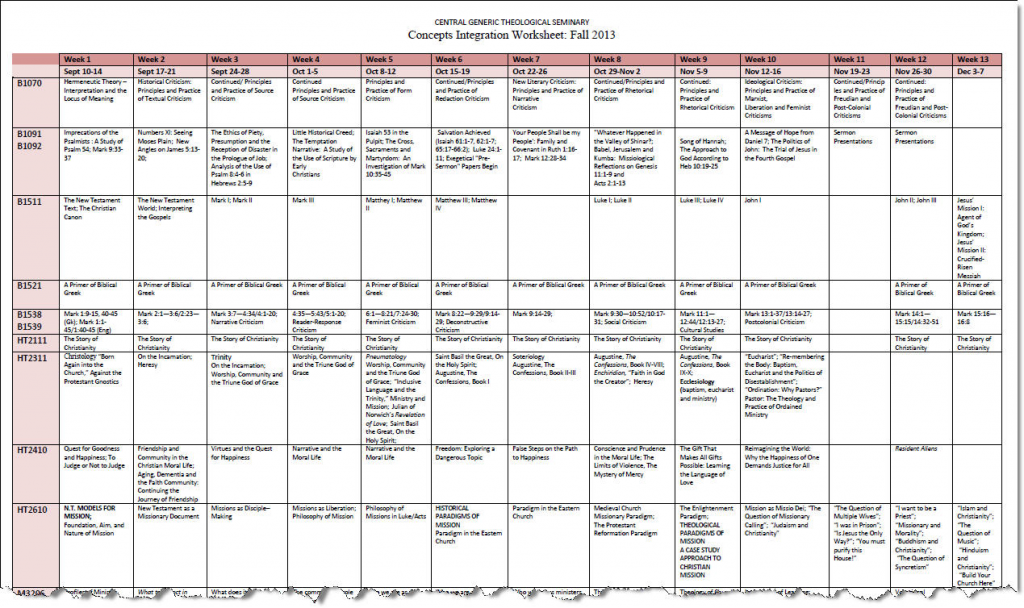Curriculum integration is an ideal theological school Faculties desire, and sometimes, strive for. Unfortunately, without intentional curriculum design, integration happens more by happenstance and serendipity than by well-crafted intent. Sometimes faculty members attempt occasional team teaching as a way to “integrate” learning. But those efforts tend to be more about team-TEACHING rather than integrative learning. Deans can help faculty members plan for integration across courses by helping them see the “big picture” of how the curriculum, as distributed among a semester’s course offerings, looks like. Curriculum maps are a great way to help faculty members see the curriculum as a whole, and, as a unified and progressive “course of study,” rather than individual unrelated courses.
Intentional programmatic integration helps mitigate the consequences of fragmentation in a “discipline silo-ed” curricular structure. “An integrated approach allows learners to explore, gather, process, refine and present information about topics they want to investigate without the constraints imposed by traditional subject barriers” (Pigdon and Woolley, 1992). With planning and purpose faculty members can help students integrate learning and see the interconnectedness and interrelationships between the curriculum areas. Rather than focusing on learning in isolated curriculum areas (courses), an integrated program of study designs learning around particular themes that are relevant to the students across the program of study. “In an integrated curriculum unit all activities contain opportunities for students to learn more about the content” (Pigdon and Woolley, 1992).
Here is one sample curriculum map that can help faculty members plan for integration: the concepts integration map. This map will provide faculty members the ability to see how key concepts are distributed across courses during a semester. The map is simple: create the map in the form of a grid, listing the courses offered during the semester on the first column. Identify the weeks of the semester across the top on the first row. It’s best to use a large format if you want to print the map (17″x11″ is a good size for this). From the course schedule that appears in each course syllabus, plot the main concept or topic for each week on the chart.

Download Concepts integration worksheet
To help faculty members plan for integration, use the map as a tool to review what is being taught “across the board.” Unless faculty members are aware of what all of the other faculty members are teaching in their courses—when, in what sequence, and to what end—it’s not likely they can intentionally integrate learning for the students. Deans can guide faculty members to identify what other professors are covering three to four weeks prior, and three to four weeks after, their own course schedule topics. Encourage faculty members to identify points of integration during that span of four to eight weeks they can work on together. Faculty can integrate the teaching and learning experience by working together in courses to:
- Synchronize coverage of topics across the span of the semester
- Align or sequence coverage of concepts across course over several weeks
- Assign comparison and contrast of concepts and readings between courses
- Assign the same reading in different courses for different perspectives, applications, or purposes
- Schedule classes to meet together for selected class sessions
- Swap professors between courses to facilitate integration on particular topics
- Assign students to share, teach, or present in a different course in points of intersection.
- Assign joint or collaborative projects related to course concepts or topics with students in different courses
Intentional integration happens by design, and, requires identified demonstrable learning outcomes. Using the concepts integration map you can guide faculty members to more effectively embed program level learning outcomes related to integration in their courses. Working together, faculty members can include the same (embedded) integrative learning outcome in more than one course. Faculty members sincerely desire to realize integrated learning in the curriculum, often, they just lack the know-how for how to do so. Using tools like curriculum maps, Deans can help faculty members see “the big picture” of the curriculum as a “course of study” and can provide a tool to bring about integration of learning by design. Integration is too important a product of learning to leave to chance and serendipity.





